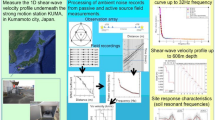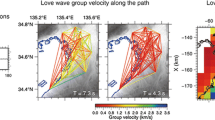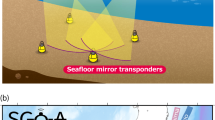Abstract
The statistical correlation between the three elastic parameters of the P- and S-wave velocities and density is significant for stabilizing the prestack inversion. In the prestack Bayesian linearized inversion (BLI), the prior correlation of the three elastic parameters is included in a multivariate Gaussian distribution, and is represented by the cross-variograms between the three model parameters. However, the cross-variograms are roughly calibrated from certain sparse existing data (such as well-log data), which may produce statistical error and reduce inversion accuracy. To address this issue, this work proposes a decorrelated Bayesian linearized inversion (DBLI) by integrating the BLI with a decorrelation strategy. The decorrelation utilizes principal component analysis to obtain independent model parameters with zero covariances. Since the cross-variograms of the model parameters are no more than their covariances according to the derivation, the cross-variograms between the three independent model parameters are also zero. Thus, the estimation of the cross-variogram is unnecessary in DBLI, thereby avoiding the statistical error produced in the prior correlation characterization. The contribution of DBLI can be summarized by two main aspects. First, DBLI enables one to avoid the problem of reduced inversion stability and accuracy caused by statistical error, which is verified by tests on both the theoretical model and field data. Second, the derived relationship between the covariance and the cross-variogram is a potential contribution to both the geophysical inversion and geostatistical modeling.














Similar content being viewed by others
References
Aki K, Richards PG (1980) Quantitative seismology: theory and methods. Freeman, New York
Alemie W, Sacchi MD (2011) High-resolution three-term AVO inversion by means of a Trivariate Cauchy probability distribution. Geophysics 76(3):R43–R55
Azevedo L, Nunes R, Soares A, Mundin EC, Neto GS (2015) Integration of well data into geostatistical seismic amplitude variation with angle inversion for facies estimation. Geophysics 80(6):M113–M128
Azevedo L, Grana D, Amaro C (2018) Geostatistical rock physics AVA inversion. Geophys J Int 216(3):1728–1739
Buland A, Omre H (2003a) Bayesian linearized AVO inversion. Geophysics 68(1):185–198
Buland A, Omre H (2003b) Bayesian wavelet estimation from seismic and well data Bayesian Wavelet Estimation. Geophysics 68(6):2000–2009
Buland A, Omre H (2003c) Joint AVO inversion, wavelet estimation and noise-level estimation using a spatially coupled hierarchical Bayesian model. Geophys Prospect 51(6):531–550
Buland A, Kolbjornsen O, Omre H (2003) Rapid spatially coupled AVO inversion in the Fourier domain. Geophysics 68(3):824–836
Castagna JP, Batzle ML, Eastwood RL (1985) Relationships between compressional-wave and shear-wave velocities in clastic silicate rocks. Geophysics 50(4):571–581
Downton J (2005) Seismic parameter estimation from AVO inversion. The University of Calgary, Calgary
Eidsvik J, Avseth P, Omre H, Mukerji T, Mavko G (2004) Stochastic reservoir characterization using prestack seismic data. Geophysics 69(4):978–993
Eidsvik J, Martino S, Rue H (2009) Approximate Bayesian inference in spatial generalized linear mixed models. Scand J Stat 36(1):1–22
Gardner G, Gardner L, Gregory A (1985) Formation velocity and density: the diagnostic basics for stratigraphic traps. Geophysics 50(11):2085–2095
Grana D (2014) Probabilistic approach to rock physics modeling. Geophysics 79(2):D123–D143
Grana D (2017a) Bayesian linearized rock-physics inversion. Geophysics 81(6):D625–D641
Grana D (2017b) Joint facies and reservoir properties inversion. Geophysics 83(3):M15–M24
Grana D, Mukerji T, Dvorkin J, Mavko G (2012) Stochastic inversion of facies from seismic data based on sequential simulations and probability perturbation method. Geophysics 77(4):M53–M72
Grana D, Fjeldstad T, Omre H (2017) Bayesian Gaussian mixture linear inversion for geophysical inverse problems. Math Geosci 49(4):493–515
Grana D, Figueiredo LPD, Azevedo L (2019) Uncertainty quantification in Bayesian inverse problems with model and data dimension reduction. Geophysics 84(6):M15–M24
Haas A, Dubrule O (1994) Geostatistical inversion-a sequential method of stochastic reservoir modelling constrained by seismic data. First Break 12(11):561–569
Hansen TM, Journel AG, Tarantola A, Mosegaard K (2006) Linear inverse Gaussian theory and geostatistics. Geophysics 71:R101–R111
Hansen TM, Cordua KS, Mosegaard K (2015) A general probabilistic approach for inference of Gaussian model parameters from noisy data of point and volume support. Math Geosci 47(7):843–865
Kjønsberg H, Hauge R, Kolbjørnsen O, Buland A (2010) Bayesian Monte Carlo method for seismic predrill prospect assessment. Geophysics 75(2):O9–O19
Lang X, Grana D (2017) Geostatistical inversion of prestack seismic data for the joint estimation of facies and impedances using stochastic sampling from Gaussian mixture posterior distributions. Geophysics 82(4):M55–M65
Malinverno A, Briggs V (2004) Expanded uncertainty quantification in inverse problems: hierarchical Bayes and empirical Bayes. Geophysics 69(4):1005–1016
Nunes R, Azevedo L, Soares A (2019) Fast geostatistical seismic inversion coupling machine learning and Fourier decomposition. Comput Geosci 23(5):1161–1172
Oliver DS (1998) Calculation of the inverse of the covariance. Math Geol 30(7):911–933
Pereira P, Azevedo L, Nunes R, Soares A (2019) The impact of a priori elastic models into iterative geostatistical seismic inversion. J Appl Geophys 170:103850
Skauvold J, Eidsvik J, Theune U (2016) A parametric model for seismic wavelets—with estimation and uncertainty quantification. Geophys J Int 205(2):796–809
Soares A (2001) Direct sequential simulation and cosimulation. Math Geol 33(8):911–926
Tarantola A (2005) Inverse problem theory and methods for model parameter estimation. SIAM, Philadelphia
Theune U, Jensas IØ, Eidsvik J (2010) Analysis of prior models for a blocky inversion of seismic AVA data. Geophysics 75(3):C25–C35
Tikhonov AN (1963) Solution of incorrectly formulated problems and the regularization method. Soviet Math 4:1035–1038
Wang W, Li G, Yu X, Yang W, Wang W (2017) A modified decorrelation method in the prestack inversion. SEG Tech Progr Expand Abstr 2017:702–706
Zhang S, Huang H, Dong Y, Yang X, Wang C, Luo Y (2017) Direct estimation of the fluid properties and brittleness via elastic impedance inversion for predicting sweet spots and the fracturing area in the unconventional reservoir. J Nat Gas Sci Eng 45:415–427
Acknowledgements
This work is partly supported by the National Key R&D Program of China (2018YFA0702502), National Key Science and Technology Program (2016ZX05010-001), and National Natural Science Foundation of China (U19B6003-04, 41630314).
Author information
Authors and Affiliations
Corresponding author
Appendix 1
Appendix 1
This appendix shows the derivation of the CCR. The CCR for the P- and S-wave velocities (\( {\mathbf{v}}_{p} \) and \( {\mathbf{v}}_{s} \)) is taken as an example.
1.1 Expressions of Covariance and Cross-Variogram Sill
The covariance \( c_{ps} \) between \( {\mathbf{v}}_{p} \) and \( {\mathbf{v}}_{s} \) can be expressed as
where E represents the mean of a vector, and \( E\left( {{\mathbf{v}}_{p} } \right) \) and \( E\left( {{\mathbf{v}}_{s} } \right) \) represent the means of \( {\mathbf{v}}_{p} \) and \( {\mathbf{v}}_{s} \), respectively.
The sill of the cross-variogram \( \gamma_{ps} \) between \( {\mathbf{v}}_{p} \) and \( {\mathbf{v}}_{s} \), \( f_{ps} \), can be expressed as
where h is the range of the \( \gamma_{ps} \) (h is commonly fixed for one variogram or cross-variogram), and \( n - h \) is the number of dot pairs with the spacing distance h in the N sampling points.
As for \( {\mathbf{v}}_{p} \) and \( {\mathbf{v}}_{s} \), the two assumptions can be denoted by
-
(I)
\( N \gg h \), i.e., the range h can be ignored compared with the number of sampling points N.
-
(II)
\( c_{ps} \ge 0 \), i.e., the correlation coefficients between different model parameters are non-negative.
1.2 Simplification of Cross-Variogram Sill
\( f_{ps} \) in Eq. (A-2) can be written as
Then, according to assumption (I) that \( n \gg h \), the first and second terms in Eq. (A-3) are transformed to
In order to simplify the third and fourth terms of Eq. (A-3), four subsequences of \( {\mathbf{v}}_{p} \) and \( {\mathbf{v}}_{s} \) are defined as
Then, the third and fourth terms of Eq. (A-3) are converted to
Thus, \( f_{ps} \) is converted to
1.3 Difference between Covariance and Cross-Variogram Sill
Combining Eqs. (A-1) and (A-7), the difference between \( c_{ps} \) and \( f_{ps} \) is expressed as
Based on assumption (I), \( E\left( {{\mathbf{v}}_{s1} } \right) \approx E\left( {{\mathbf{v}}_{s2} } \right) \approx E\left( {{\mathbf{v}}_{s} } \right) \). Then, it is approximately expressed as
where \( c_{ps1} \) is the covariance between \( {\mathbf{v}}_{p1} \) and \( {\mathbf{v}}_{s1} \), and \( c_{ps2} \) is the covariance between \( {\mathbf{v}}_{p2} \) and \( {\mathbf{v}}_{s2} \). The nodes in \( {\mathbf{v}}_{p1} \) do not absolutely correspond to the nodes in \( {\mathbf{v}}_{s1} \) due to the time shifting caused by the range h. Thus, \( c_{ps1} \) and \( c_{ps2} \) are approximately less than \( c_{ps} \). However, according to the assumptions (I) and (II), the correlation between \( {\mathbf{v}}_{p1} \) and \( {\mathbf{v}}_{s1} \) should still be positive, and the correlation between \( {\mathbf{v}}_{p2} \) and \( {\mathbf{v}}_{s2} \) should also be positive, i.e.,
It can then be observed from Eq. (A-9) that the relationship between \( f_{ps} \) and \( c_{ps} \) is
Therefore, the CCR in Eq. (5) is derived.
Rights and permissions
About this article
Cite this article
Yu, B., Zhou, H., Wang, L. et al. Prestack Bayesian Linearized Inversion with Decorrelated Prior Information. Math Geosci 53, 437–464 (2021). https://doi.org/10.1007/s11004-020-09899-6
Received:
Accepted:
Published:
Issue Date:
DOI: https://doi.org/10.1007/s11004-020-09899-6




